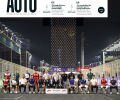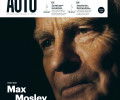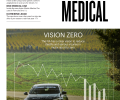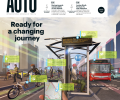AUTO #16 - Cities without limits
New driverless technology is poised to help solve the growing problem of traffic congestion in our cities – with urban planning a hot topic for the United Nations

The way we move around our cities will change more in the next decade than in the last 100 years.
Ground-breaking technologies like electric, self-driving and fully autonomous cars being pioneered by Google and Tesla are poised to tear up the rulebook when it comes to urban mobility, dethroning the internal combustion engine’s dominance over movement.
At the same time a renaissance is taking place among city planners in the way they’re thinking about transport itself. Old goals like the efficiency and speed of vehicles are being replaced with new metrics like health, well-being and the happiness of a city’s population.
This October the United Nations will hold its third Conference on Human Settlements, also known as Habitat III. National governments, regional mayors and local leaders will come together to tackle the key questions facing sustainable urbanisation over the next 20 years.
Of these questions, mobility is set to be one of the defining topics of the conference. Representatives of developing cities, established cities and the world’s biggest mega-cities alike are struggling to manage swelling populations and transit systems reaching breaking point.
Their findings and decisions will be published as part of the UN’s New Urban Agenda, a non-binding document to shape and guide the political discourse around our urban centres for the next two decades.
For context, the last urban agenda, agreed at Habitat II in 1996, paved the way for 100 countries to adopt new legislation guaranteeing adequate shelter for their citizens and set the programme for dozens of UN policies on urban development.
The New Urban Agenda is expected to be just as impactful.
AUGMENTING THE CAR
Among the world’s leading thinkers, there’s one looming challenge as Habitat III approaches – finding alternative transport solutions.
“It’s very simple – weaning us off the drug that the internal combustion engine has become, in terms of individualised transport and even some types of public transport,” says Riccardo Marini, director at Gehl Architects, one of the world’s leading urban design firms.
But it’s not about replacing the car, instead city planners and mobility experts are in favour of augmenting the car, either by prioritising other modes of transport (walking, cycling and public transport) or by removing our need to own cars.
“The big game-changer is certainly Google’s self-driving cars,” says Robert Cervero, professor of city and regional planning at the University of California, Berkeley.
“While many auto manufacturers are introducing autonomous vehicle technologies, such as automated park-assist and adaptive cruise control technologies, it’s the driverless vehicle – guided by laser, radar and sonar sensors – that could radically change how we move about cities.”
Not, Cervero says, by giving everyone a self-driving car, but instead by using them to create fleets of vehicles that can be used by anyone travelling in the same direction.
BEYOND DRIVERLESS
Most estimates peg car utilisation today, the amount of time the car is actually being used, at only between four-five per cent of the time. Despite a car being the second largest financial investment of most families, most of the time it is simply parked unused.
The vision shared by Cervero and the CEO of ride-sharing app Uber, Travis Kalanick, is of an autonomous fleet of cars that could see their utilisation rates rise to 80 or 90 per cent of the time, leading to far fewer cars being needed on the road.
Lithium’s electric taxi business model is unique. The group currently only serves corporate clients who pay a flat fee to access a fleet of 200 electric cabs, which they can then use on an unlimited
basis for no additional charge. “It’s the energy problem related to mobility that is the one that’s going to be addressed most quickly by electric mobility, and in that process we will introduce shared mobility.”
It’s still early days, but Lithium hopes to increase its fleet to 400 vehicles soon and eventually launch a version for consumers.
Google’s driverless cars and driven electric fleets pioneered by companies like Lithium are different in their execution, but both envisage a future where new technologies let people share and pool resources to reduce the number of cars on the road.
“The principle of the sharing economy where the collective is more important than the individual, that could be really powerful,” says Gehl’s Marini.
A NEW MINDSET FOR MOBILITY
For now at least this driverless vision of cities remains just a vision, and while ride-sharing through services like UberPool and Lyft Line are growing in popularity, they remain niche modes of transport.
Instead most cities are simply focusing on dealing with the congestion they already have and, according to Mahesh, that’s part of the problem.
“Congestion has become the origin of our thinking about mobility, in fact if there wasn’t any congestion I doubt there would be much of a discourse about mobility,” he says.
There’s a growing mindset among city planners and urban mobility experts that the predominant goal behind most 20th century city design, making urban environments as vehicle-friendly as possible, is simply broken.
“Wellness has to be the origin of our thinking about mobility and in turn we will address congestion,” adds Mahesh.
Focusing on the health impact that transport choices can have on a population and giving people the option to travel how they wish – supporting other modes of travel with pedestrianisation or the construction of cycle highways – has been proven to reduce the burden on our roads.
MISSING THE POINT
“Many cities get distracted by tinkering around to make the system work for vehicles, but to me they’ve missed the point,” says Marini. San Francisco uses a system called SFPark, with wireless sensors that detect which parking spaces are in use and dynamically changes the price of parking around the city to encourage people to park in less congested areas.
Meanwhile Singapore and London have introduced variable congestion charges, which can be adjusted by location, time of day or vehicle type to deter drivers from taking their cars through the city centre during peak hours. Both are high-tech ways to manage and augment car travel, but neither comes close to resolving the problem.
“Start from the principle that a city centre should make it easier for pedestrians, cyclists or any other sub-set of people walking, because it has total direct impact on air quality, health, well-being and it makes the place more attractive,” says Marini.
It’s a powerful idea, and one that’s popular in the developed world. But it’s among less developed cities and poorer emerging mega-cities (with populations in excess of 10 million people) where this idea isn’t catching on for one simple reason.
THE DEVELOPING CHALLENGE
“If I’m in Africa, parts of Latin America or China, once you move out from the big centres of habitation, cycling is for poor people,” says Marini.
In his experience the local and regional officials in developing cities are often squarely focused on increasing the number of drivers and cars on the roads, without regard for the paralysing hyper-congestion they might face in the future.
Marini recalls the mayor of one city in eastern Europe telling him: “You must remember we’re coming out of the Soviet era, we want the American dream, we don’t want people cycling any more”.
That’s a problem because these cities are among the world’s most populous and to promote the automobile at the expense of encouraging pedestrianisation and the use of public transport will leave them gridlocked and could contribute to increased pollution.
PUTTING PEOPLE FIRST
Technology will transform the way we move around cities over the next decade, but technology alone won’t be enough to solve the urban mobility crisis facing cities.
As Marini says: “The biggest challenge is how to understand that movement is critical, but car-dominated movement is actually negative in terms of health, well-being and happiness.”
Leaders at the UN’s Habitat III conference will need to debate this new mindset for urban mobility. A mindset that blends the future of driverless cars with the values of a sharing economy, where not everyone needs to outright own a car any more – and a mindset that prioritises the welfare and the happiness of people.
That’s a big jump in thinking for governments, regional mayors and leaders who, for the past hundred years, have focused on maximising the movement of vehicles.
But it’s a jump that may need to happen.
Click here to read this issue online.

 Facebook
Facebook Twitter
Twitter






